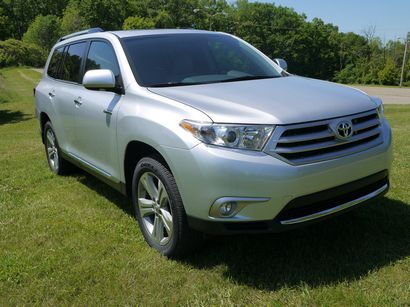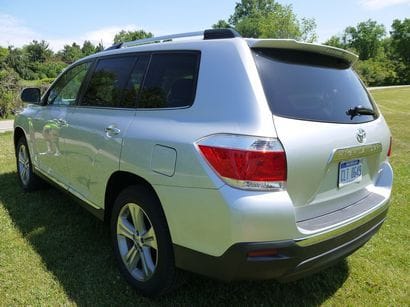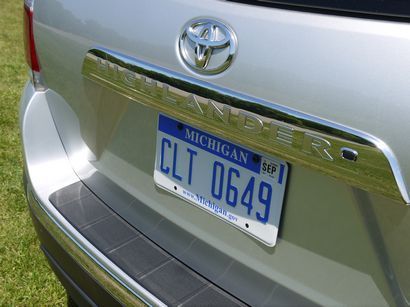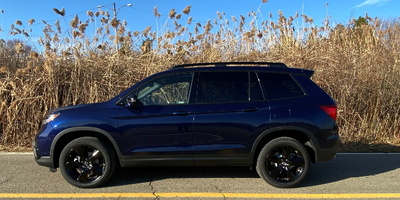A week spent in the midsize crossover SUV from Toyota
Pros:
Refined engine and transmission
Interior room
Versatility
Cons:
Uninspired styling
Steering feedback
Handling
Wrapping it up
Back in March of this year, Toyota unveiled the third generation of its Highlander midsize SUV at the New York Auto Show. Since we've never had the chance to review the second-gen version and 2013 marks this model's last hurrah (the 2014 Highlander will be available early next year), we though it high time we check it out.
For starters, although it might seem that the Highlander has been around for nearly forever in Toyota's lineup, it turns out this Camry-based ute is one of the newer nameplates, having been introduced in 2001. Since then, just four other models (aside from various hybrid derivatives) have been added – Matrix, Venza, Prius c and Prius v.
Unlike its platform-mate the RX 350, which carries the Toyota Harrier nameplate in its home country, we much prefer the name "Highlander" to what it's called in Japan – the "Kluger. "
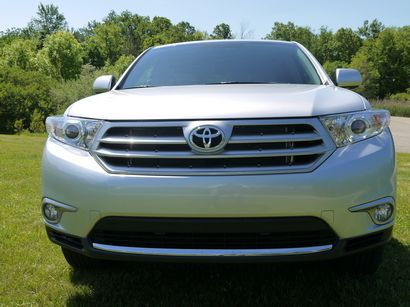
2013 Toyota Highlander
Back in 1998, Lexus was the first luxury brand to base a sport utility vehicle on a unibody platform – in this case the Toyota Camry – and succeeded in creating a whole new type of sport utility vehicle, the crossover. Two years later, a Toyota-badged model based on the same platform, called the Highlander, was unveiled at the New York Auto Show, going on sale in January of 2001.
Assembled at the same Princeton, Indiana manufacturing facility that builds the larger body-on-frame Sequoia SUV, the Highlander is a three-row crossover that offers a choice between four-cylinder and V6 engines and either front-wheel drive or full-time four-wheel drive powertrain configurations.
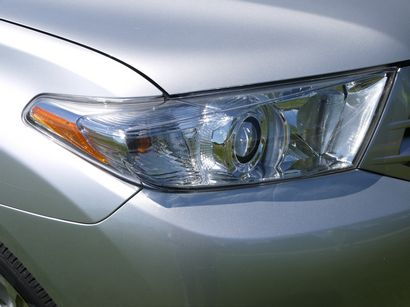
The standard 2.7-liter inline-four generates 187 horsepower at 5,800 rpm and 186 lb.-ft. of torque at 4,100 rpm. The larger engine which it shares with the Lexus RX is a 3.5-liter DOHC all-aluminum V6, featuring dual variable valve timing, which produces a creamy 270 horsepower at 6,200 rpm and 248 lb.-ft. of torque at 4,700 rpm (rated at 17/22/19 city/highway/combined by the EPA while our observed fuel economy was 18.3 mpg in primarily city driving).
The four is mated to a six-speed electronically controlled automatic transmission, while the V6 makes do with one less forward gear - a five-speed, electronically controlled automatic tranny with selectable manual sequential shifting.
Toyota's largest crossover features four-wheel independent suspension using MacPherson struts in front and a dual-link strut setup in the rear. All Highlander models also come with a corner-braking feature that limits brake pressure on inside wheels during cornering to help enhance control through the turn.
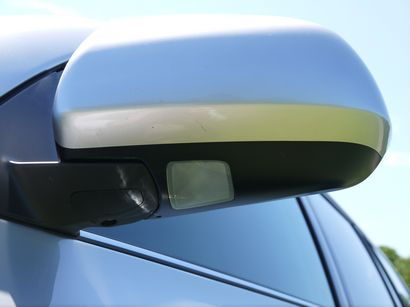
Exterior
Since the new and improved model has already broken cover, we'll cut Toyota a little slack when it comes to the current-gen Highlander's styling.
That's because, being generous, it's difficult picking out a 2013 Highlander in a sea of similarly-sized SUVs in a crowded parking lot.
Aside from a pair of clear narrow headlamp enclosures that cantilever over the outward edges of the front fascia, there's little else - including a two bar grille and smallish lower air intake - to differentiate the Highlander from a slew of other large people haulers.

The plain sides also don't add much to the mix, although things get interesting with a pronounced shoulder line just below the massive D-pillars.
In back, things once again revert to plain and tall although there is one particularly nice touch: the rear window opens independently allowing you to load items without having to open the massive tailgate.
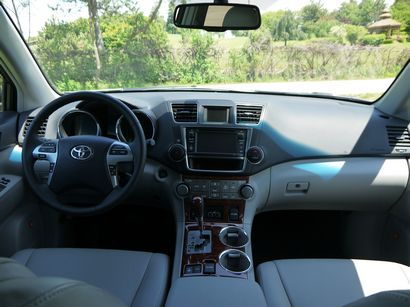
Interior
Inside, the Highlander is a typical Toyota. Soft touch surfaces abound with light and dark gray surfaces offset by rich-looking wood trim. Overall fit and finish is excellent and, like its Lexus platform-mate, the highlight is a stunning one-piece upper dashboard cover.
The steering wheel both tilts and telescopes. Leather heated front seats are both firm and supportive with just the right amount of side bolstering while the 10-way driver's seat on our Limited (the passengers is also 10-way) featured an adjustable thigh support, not something normally found on vehicles in this class.
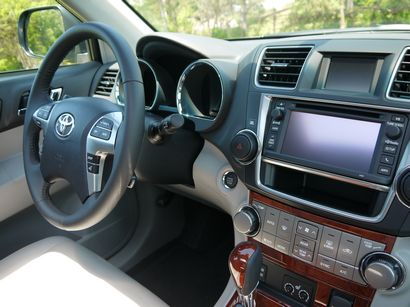
Instrumentation is clear and easy to read, with the smooth console and center-stack buttons and controls being very intuitive. Kudos to Toyota for another design feature: the various buttons and knobs on the center stack are not only backlit and within easy reach of the driver, they're also good-size and fly in the face of current interior design convention that sacrifices usefulness on the altar of style.
Front seat passengers enjoy a generous amount of head, shoulder and leg room. In back, up to three rear-seat passengers will find a nearly flat floor, along with plenty of room, featuring high-sitting and well-shaped seats along with easy ingress and egress.

Center seat occupants will also find plenty of head, shoulder and hip room in the reclining captain's chairs, both with inboard arm rests and fore-aft adjustment which come with another interesting feature: a removable center console. If a third person needs to sit in the center row (not a bad idea), the console comes out and, hidden in a compartment under the front console is the third seat that can be inserted and locked between the two outboard seats. The rear center console can then be stored in the front console storage compartment.
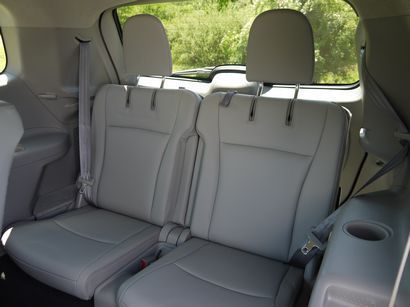
Like many three-row utilities, however, the third row is best designated as a preserve for small children or folded flat for additional cargo space for two reasons: there's a dearth of leg room at just 29.9 inches and, with the rear seats up, the headrests steal much of the rear window's available real estate.
Having said that, cargo volume behind third seat is a parsimonious 10.3 cubic feet but expands to a more generous 42.3 cubic feet with the third row folded flat. With both rear and middle seats down it transforms into a cavernous 95.4 cubic feet.

On the road
The V6 is smooth, powerful and refined with strong acceleration and the Highlander's cabin is refreshingly quiet even at freeway speeds. It tracks nicely down the road while suspension compliance is excellent with body lean being well controlled through the corners, especially for a vehicle of this size and heft. Braking is also very good and it's easy to modulate the brake pedal.
But that, unfortunately, is pretty much where any dynamic goodness ends. Overall handling is mediocre at best and there's very little in the way of feedback through the steering wheel. Most Highlander models are equipped with a backup camera which is a good thing because rear quarter visibility is often impaired by the wide C-pillars.

Equipment and pricing
Although the Highlander has very few stand-alone options, Toyota's somewhat byzantine system of trim levels (four non-hybrids), engines (two) and option packages (typically one per trim level) plus a dozen or more dealer or port-installed options, makes matters more complicated than, say, Honda's system.
All Highlander models come with Toyota's Display Audio featuring a 6.1-inch touch screen that includes iPod connectivity, hands-free phone capability and Bluetooth technology, power windows, locks and mirrors plus air conditioning, cruise control, 3.5-inch multi-information display, 7-passenger seating, projector beam headlamps, privacy glass, keyless entry, intermittent front wipers and a variable rear wiper and 17-inch alloy wheels with a full-size spare.

Plus models receive, among other things, a lift-up glass hatch, roof rails, fog lamps, the middle center-stow seat, backup monitor and cargo area cover.
The SE trim level adds a power moonroof, power liftgate, leather seats (heated in front), steering wheel and shift knob, leatherette 50/50 split third row seat and an auto-dimming inside rearview mirror.
Finally, the Limited trim level adds 19-inch alloy wheels (with the spare on an alloy wheel as well, power heated and folding outside mirrors, 3-zone automatic climate control, perforated leather seats and wood-grain style interior trim. Also included is Toyota's Display Audio with navigation along with JBL speakers, XM satellite radio and HD radio with iTunes tagging.
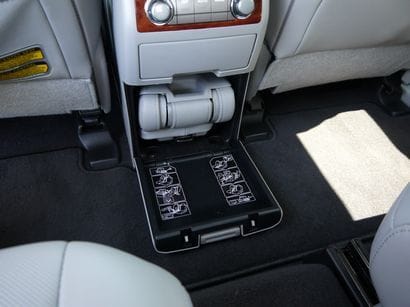
New car prices, including an $845 destination and handling charge, begin at $29,715 for a front-wheel drive 4-cylinder base model and top out at $44,556 for an optioned-with-all-the-goodies Limited all-wheel-drive example.
Our tester, a Classic Silver Metallic, all-wheel-drive Limited had a base price of $439,250.00. Adding the Rear Seat Entertainment system (DVD with 8-inch display and w wireless headphones - $1,760.00) brought the total MSRP, including delivery, to $41,855.00.
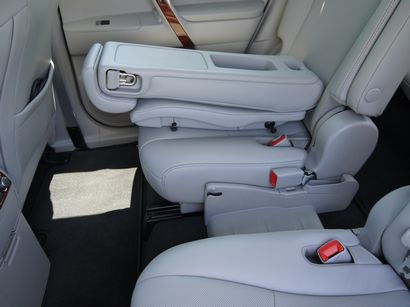
The Bottom Line
It's easy to see why the Highlander is a best seller. It's got lot going for it – good fuel economy, a quiet ride and a comfortable, spacious interior. It could stand to have more style (maybe why the Ford Explorer out-sells it) but that is at least partially being addressed with the new model due next year. These issues, coupled with the fact that it could use a more responsive steering setup and better handling, will probably be overlooked by most buyers seeking Toyota's legendary quality and reliability in a large people mover.


